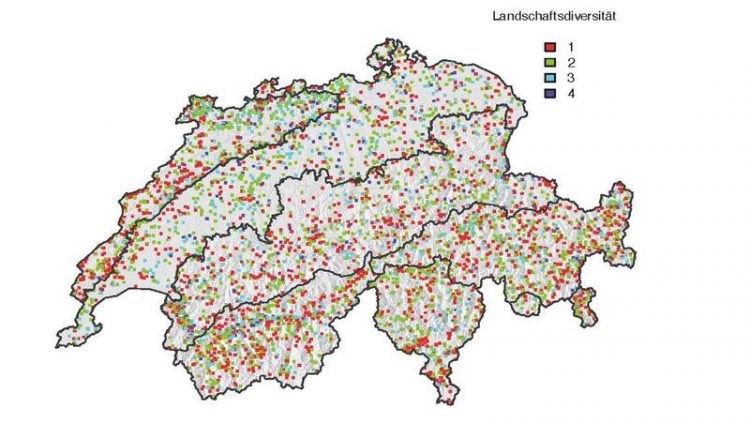Improved Functioning of Diverse Landscape Mosaics

Map: the approx. 5,000 Swiss landscape plots examined University of Zurich
To date, biodiversity research primarily focused on the number of plant species present in ecosystems. “Most studies so far have used small, artificially established study plots. However, real-world landscapes are much more complex, and, in addition to natural areas, also contain human-dominated elements such as arable land and urban areas”, says Pascal Niklaus, professor at the Department of Evolutionary Biology and Environmental Studies at the University of Zurich (UZH).
5,000 Swiss landscapes analyzed
A research team led by Niklaus and part of the Research Priority Program “Global Change and Biodiversity” investigated how different land-cover areas affect vegetation growth in large landscapes. Using aerial imagery, they assessed land-cover in 4,974 landscape plots from all regions in Switzerland. In addition to green areas such as grassland and forest they also considered human-dominated areas including arable fields and settlements. In parallel, they used satellite data to determine plant productivity in these landscapes over a period of 17 years.
Land-cover mixtures are more productive and stable
“We found that landscapes consisting of a mosaic of different land uses were more productive than the average landscape with uniform use”, Niklaus summarizes. This positive effect of land-use diversity and productivity held over many regions, climatic conditions and altitude ranges. Landscape mosaics also showed a temporally more stable productivity. In other words, more diverse landscapes are able to mitigate effects of inter-annual climate variation.
Different mechanisms are at play
The positive effects of land-use diversity were unrelated to the number of plant species present in these landscapes. This indicates that areas with different land uses interact and improve the functioning of the entire landscape, similar to the way in which plant species interact in a small patch of vegetation and thereby improve the functioning of the plant community.
“In such large landscapes, novel mechanisms must be at play that do not operate in the small study plots traditionally examined in biodiversity experiments”, Jacqueline Oehri, first author of the study, says. The specific nature of these mechanisms is the subject of further investigations. The authors speculate that, for example, urban areas and water bodies affect climatic conditions in their surroundings, and that this might improve the productivity of vegetation in these areas.
Strategies for regional planning and landscape management
The way in which different land uses are spatially interwoven thus promotes the functioning of landscapes, in addition to the established beneficial effects of high species diversity. The study’s novel approach enables landscapes to be analyzed on a scale that is relevant for regional planning and conservation policies.
However, Niklaus emphasizes that “the fact that mixed landscapes function better should not be understood to mean that natural areas should be fragmented by expanding urban settlements”.
Prof. Dr. Pascal A. Niklaus
Department of Evolutionary Biology and Environmental Studies
University of Zurich
Phone: +41 44 635 34 13
E-mail: pascal.niklaus@ieu.uzh.ch
Jacqueline Oehri, Bernhard Schmid, Gabriela Schaepman-Strub, Pascal A. Niklaus. Terrestrial land-cover type richness is positively linked to landscape-level functioning. Nature Communications. 9 January 2020. DOI: 10.1038/s41467-019-14002-7
https://www.media.uzh.ch/en/Press-Releases/2020/Landscape-Richness.html
Media Contact
All latest news from the category: Ecology, The Environment and Conservation
This complex theme deals primarily with interactions between organisms and the environmental factors that impact them, but to a greater extent between individual inanimate environmental factors.
innovations-report offers informative reports and articles on topics such as climate protection, landscape conservation, ecological systems, wildlife and nature parks and ecosystem efficiency and balance.
Newest articles

Humans vs Machines—Who’s Better at Recognizing Speech?
Are humans or machines better at recognizing speech? A new study shows that in noisy conditions, current automatic speech recognition (ASR) systems achieve remarkable accuracy and sometimes even surpass human…

Not Lost in Translation: AI Increases Sign Language Recognition Accuracy
Additional data can help differentiate subtle gestures, hand positions, facial expressions The Complexity of Sign Languages Sign languages have been developed by nations around the world to fit the local…

Breaking the Ice: Glacier Melting Alters Arctic Fjord Ecosystems
The regions of the Arctic are particularly vulnerable to climate change. However, there is a lack of comprehensive scientific information about the environmental changes there. Researchers from the Helmholtz Center…



